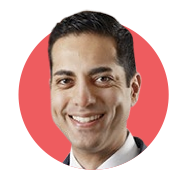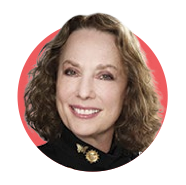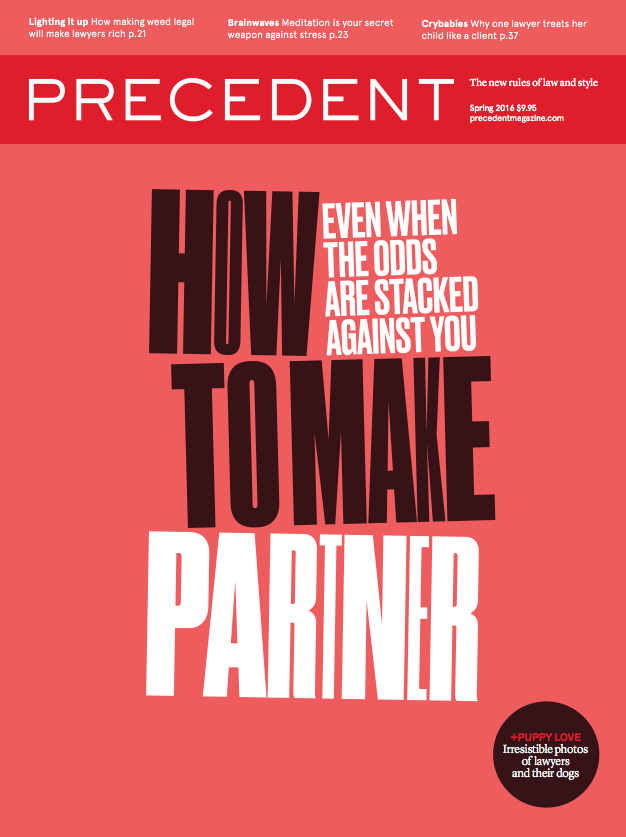1. Pass the lunchtime test
Making partner at McLeish Orlando LLP takes stellar legal work, rainmaking savvy and something less tangible. “I’ve got to want to have lunch with that person, only because I enjoy their company,” says John McLeish, co-founder of the 14-lawyer personal injury firm, which has seven partners. “We call it the lunchtime test.”

“We all make an effort to know each other on a personal level.”— Rikin Morzaria, McLeish Orlando LLP
And associates take the test nearly every day. “Unless I’m at a discovery or a mediation, I almost always have lunch with the rest of the firm,” says Rikin Morzaria, who made partner at McLeish Orlando in 2011, as a seventh-year lawyer. He says he chats about his personal life as often as he does about work. For Morzaria, that means providing updates on his two young children, while the hockey players on staff recount their latest on-ice triumphs. “We often have different interests outside of work,” says Morzaria. “But we all make an effort to know each other on a personal level.”
At any small firm, notes McLeish, everyone has to gel. “At a large firm, some lawyers might not even know each other’s names. But there’s no hiding at a small firm.” And McLeish says that’s a good thing: no one should want to hide. “I love all my partners and I love coming to the office. If I don’t like the lawyers, it’s not going to work for them and it’s not going to work for me.”
2. Master the small-firm formula
One afternoon in October of 2014, Jacquelyn Stevens marched nervously into a boardroom at Willms & Shier Environmental Lawyers. At the table sat the five partners of the 14-lawyer environmental boutique. Stevens, a tenth-year associate, was about to argue that she, too, should be a partner at the firm. It was the biggest moment of her career.

Being a partner is a big responsibility. We take it seriously.— Donna Shier, Willms & Shier Environmental Lawyers
Like many small firms, Willms & Shier doesn’t have a partnership track. When associates want to take the leap, they are encouraged to make the first move and pitch themselves to the partners. If the partners like what they hear, associates become “partners-in- training” — kickstarting a trial period of at least one year, throughout which they attend all partnership meetings and see all the financial information for the first time. Only if the trial period goes well can they join the partnership, and have an equity stake in the firm. The vetting process is long. And that first meeting is no joke.
“It’s one of those times when they come in and straighten their ties,” says Donna Shier, who co-founded the firm 37 years ago. “This firm is how we support our families and our staff. Being a partner is a big responsibility. We take it seriously.”
Indeed, it’s a rare occasion when the firm’s relaxed tenor dissipates. Stevens felt the pressure. “It was pretty stressful,” she recalls. “Because I knew they might say no.”
But Stevens had prepared a detailed presentation that touted what she could bring to the business — and her pitch sheds light on what it takes to make partner at a small firm. For one thing, Stevens raised her reputation as a hyper-specialist. Most small shops, after all, brand themselves as the leading lawyers in a narrow field of law. On this point, Stevens introduced ample evidence in her favour: she was a certified specialist in environmental law and a superstar in a range of environmental areas, from mining to renewable energy.

He shook my hand, gave me a hug and said, ‘You’re in.’— Jacquelyn Stevens, Willms & Shier Environmental Lawyers
She also had a strong reputation in the dry-cleaning law world, where she’s a go-to lawyer for both industrial cleaners and property owners who have sued such cleaners for damaging their land. At the office, colleagues called her “the dry-cleaning queen.”
Next, Stevens had to prove she could bring in new clients, a touchstone for partnership at all firms. But rainmaking at small firms is a unique challenge. “Most small firms don’t have institutional clients that feed it all of its work,” says Stevens. “Most of my work comes from one-off clients.” Business development, in other words, is a constant grind. Which is why Stevens keeps in touch with potential clients year-round. For instance, she reaches out to them and says, “I hope you don’t have any problems, but if you do, remember to give me a call.” And, as she told the partners, that tactic has borne fruit. “It’s taken six years, but I finally feel like I’ve gained the trust of certain clients, and I’m getting files.”
At the end of her presentation, Stevens ambled back to her office, leaving the partners to confer. Five minutes passed. She heard a knock at the door. “It was the managing partner, Marc McAree,” she recalls. “He shook my hand, gave me a hug and said, ‘You’re in.’”
Stevens went on to spend all of 2015 as a partner-in-training. Then, this January, she broke out of that cocoon, and emerged as a full-fledged equity partner. “It’s a big responsibility,” she says. “But you know what? I’m ready for this.”
 This story is part of our series on making partner, from our Spring 2016 issue.
This story is part of our series on making partner, from our Spring 2016 issue.


